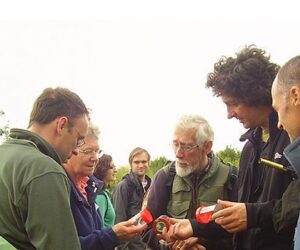Spot the Difference
The peregrines are still doing well here at the Falls of Clyde. Over the last couple of days they have been busy incubating their newly laid eggs and gathering food. The female (Falcon) and the male (Tiercel) will take turns incubating the eggs for 4 weeks with the chicks expected to hatch the second week in May. Yesterday it was the female who was seen on the nest (eyrie) the most, with the male only flying in from time to time to bring her food. At first glance, it can be hard to distinguish between the male and female, so here are a few tips to spot the difference between them:
The first, most obvious difference between the birds is their size. The female is larger than the male (tiercel actually comes from the Latin tertius which means one third, as he is one third smaller than the female). The female has a wing span from 104cm-113cm and the male one of 89cm-100cm. The size difference between the birds means that the male is faster but can only catch smaller birds due to his size whereas the female hunts the larger birds. This means that they have a larger selection of prey and are not competing for the same food source.
Another obvious difference is the face markings of the birds. The falcon has a very white face with a distinctive black ‘moustache’ mark on her cheeks. The tiercel has a much darker face, he also has the moustache marks but they are not as pronounced.
Finally the tiercel has a bright egg yolk yellow mark above his beak with the same colour feet. The falcon has the same yellow marks but they are less bright, and a more creamy yellow.
Have a look at the photographs and see if you can pick these points out for yourself!
Katy Green: Seasonal Ranger
Help protect Scotland’s wildlife
Our work to save Scotland’s wildlife is made possible thanks to the generosity of our members and supporters.
Join today from just £3 a month to help protect the species you love.
Preface
The peregrines are still doing well here at the Falls of Clyde. Over the last couple of days they have been busy incubating their newly laid eggs and gathering food. The …

